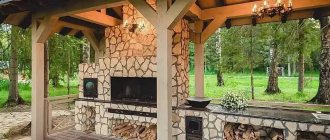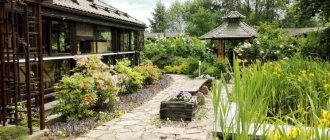Selecting a location
Before you begin to implement your plan, walk around your dacha and carefully examine its corners. Then, when planning how to make a rose garden, this will make it possible to correlate the projects you see with the possibility of implementing them at home.
You will see the usefulness of this idea when you become acquainted with the main types of rosaries. Each of them will find its place in a specific place on the site. It is important that the place for the rose garden is dry and sunny; the best soil is light loam with an acidity close to neutral - 5-7.
Selection and preparation of a landing site
First, let's clarify the definition of a flower bed. Many novice gardeners confuse it with a flower garden. And although these are similar concepts, it is worth distinguishing between them.
A flowerbed can be part of a flower garden. This is a small (usually) area located on an embankment. It is distinguished by its geometric shape and clear boundaries.
It is precisely this landscape object that we will talk about in the article. You can arrange it as follows.
- At the wall of the house. It will to some extent protect the bushes from wind and frost. To make plants feel comfortable, maintain a distance of 50-60 cm between them and the building.
- At the fence. Such hedges are very beautiful, but you need to make sure that the seedlings are not in the shade and are planted at a distance of half a meter from the building.
- Along the edges of the garden path. This planting scheme looks impressive and at the same time ensures favorable conditions for the flower.
- Near the swing, bench, gazebo. The seating area is an excellent place for a picturesque flower bed.
In fact, you can make a bed in any corner of the site. The main thing is that it is well lit. This is one of the main requirements. But there are varieties that can be grown in partial shade and in low light. Looking ahead a little, we list their names.
- Tequila (Floribunda).
- Veilchenblau ("Floribunda").
- Mary Magdalene (David Austen).
- Gebruder Grimm ("Floribunda").
Musk hybrids, polyanthus and Rugosa hybrids, Gallic, Damascus, and Portland varieties are suitable.
Partial shade - 3-4 hours a day the area is in direct sunlight, in the morning and evening there is side lighting. Sparse lighting - light hits the object through a fence mesh, tree crown, etc.
It is better if the plantings are protected from strong winds. In this regard, the location of any building is much more advantageous than an open area. The eastern part of the dacha is considered the ideal side.
- Landscape
What flowers to plant to bloom all summer: 15 best options
Soil composition for the garden bed
When the time comes for planting, you need to ensure good drainage if the groundwater is closer than two meters from the surface. To do this, remove 70 cm of soil, pour gravel into the trench and return the soil back.
Seedlings love fertile, moisture- and breathable soils. If the soil is initially heavy and dense, peat or sand is added to it. You can make the following composition:
- Peat mixture (2 buckets).
- Compost (2 buckets).
- Loam (1 bucket).
- Sand (5 liters).
- Vermiculite (5 liters).
- Landscape
10 beautiful flowers that will bloom in your garden even without care
Types of rosaries by layout
By reading the descriptions of the types of rose gardens, you will be able to determine the most suitable one for your dacha, add it to the scheme and subsequently implement it.
Landscape rose garden-flower garden
For small dachas with a small territory, a landscape flower garden is well suited. He uses varieties of roses with different color shades. Roses are combined with other types of flower plants: annual and perennial.
A landscape rose garden does not require special layouts; it looks good with a pond.
The use of landscape roses in urban landscaping
We all see how our cities and towns have become prettier over the past few years. The state allocates significant funds for landscaping and landscaping. Now every square meter of unpaved land, every tree or shrub is under the close supervision of specialists. Our parks, streets and squares are decorated with emerald lawns and colorful flower beds of annual and perennial flowers, ornamental shrubs and trees.
But now we want to talk about landscape roses. Why about them? Firstly, the beauty of blooming roses rarely leaves anyone indifferent, so they can play an important role in creating the architectural and artistic appearance of the city. Secondly, today breeders from different countries have already developed a sufficient number of varieties of various colors and low maintenance, which are specially designed for planting in urban areas.
Mainly, selection in this direction is carried out on the resistance of roses against leaf diseases, the ability to winter without shelter, the continuity and duration of flowering. Therefore, roses from the groundcover group, both creeping and compact, as well as some roses from the floribunda group are most often used as landscape roses.
Inspired by the ideas of landscape design specialists and obeying modern trends, European rose growing companies are successfully developing this topic. Roses intended for urban greening undergo very stringent tests for many years in harsh climatic conditions, and only the hardiest of them are then selected for propagation and further sale.
Thus, (France) has an assortment of more than a dozen varieties of landscape roses with winter hardiness down to -30°C and more than 20 varieties with winter hardiness down to -40°C. A variety like Knock Out can withstand Siberian frosts without shelter! More than 65 thousand bushes have already been growing in Moscow since 2006! And 30 thousand bushes of the Bonica variety , also included in the list of the most frost-resistant varieties, have been growing without shelter for 5 years in Tomsk (under the name “Tomichka”) and in Novosibirsk. Crimson Meillandecor , renamed in 2005 to the Pobeda variety and growing in the Moscow Victory Park in the amount of 10 thousand bushes, do without winter shelter
| Knock Out | Bonica |
| Crimson Meillandecor | |
The basis of the German assortment is made up of landscape roses, which are abundant in flowers beyond measure, and flowering continues continuously
all summer, right up to frost. This company specializes in creating roses with very high resistance to leaf diseases. Not without reason, half of the varieties she bred have the German predicate ADR, which is assigned only to the hardiest and most resistant varieties, so many of them are well suited for planting in places that are not optimal for growing roses.
Among the new selections from the House of Noack are the following varieties:
Alea , characterized by very compact and dense bushes, well suited for narrow ridges.
Resonanz - received for its excellent qualities, namely (resistance of leaves to diseases, vigor of growth and stability of flower color), in addition to the ADR predicate, one of the highest awards in Europe - the title "Golden Rose of the Hague".
Sorrento , whose plantings look great from afar.
Westzeit with a very interesting play of shades, from orange-apricot to pink.
| Alea | Resonance |
| Sorrento | Westzeit |
I would especially like to note the breeding achievements of the rose garden (Germany), which for many years has been developing a special program for the selection of especially resistant , beautiful and problem-free roses for decorating open urban spaces.
Landscape designers from this company offer a new approach to the color scheme and structure of plant placement used in urban landscaping. For these purposes, specially designed ground cover roses of the “ City - flor ” , which are distinguished by their unpretentiousness, abundant flowering until frost and low maintenance costs. Their bushes branch well, quickly grow and close, forming a continuous flower carpet, delighting with its splendor until late autumn . With an optimal planting pattern, dense and healthy foliage prevents sunlight from reaching the ground, creating a barrier for weed growth. All varieties are highly resistant to black spot and powdery mildew and practically do without chemical treatments . These roses overwinter without shelter, which is very important for growing in central Russia; lunges are excluded in plantings. Winter protection is only needed when there are severe frosts without snow . Then it is advisable to cover with spruce branches, which prevents the plants from drying out in winter. Roses from the City-flor group are capable of revolutionizing the range of flowering plants suitable for landscaping cities, because they are attractive, strong, maintenance-free roses that bloom close to the ground for planting in parks against lawns, in masses in squares, in borders along streets , in a word, wherever there is close traffic and there are a lot of pedestrians.
These roses are low cost. They are planted for a period of 6-10 years, their densely branched bushes remain compact at the same time and do not require regular annual pruning and shaping in comparison, for example, with a lawn, which must be mowed frequently. Only once every 5-6 years is radical pruning of overgrown bushes carried out. Roses are watered, although in a larger volume, but much less frequently than watering lawns and flower beds of annuals. This eliminates the need to frequently use watering equipment.
The costs of planting material in the first year exceed the same figure for annuals by only 30%. But, if we take into account that we have to purchase annuals every year, and roses once every 6-10 years, then even multiplying the figure by 6, we will get a 4-fold saving on planting material! So, with the average cost of annual seedlings being 12 rubles and the planting rate being 40 pcs. per sq.m., the total cost is 480 rubles, and multiplying by 6 years, we get an amount of 2880 rubles. And when planting ground cover roses, the requirement per 1 sq.m. averages 4 plants, with a wholesale price of 180 rubles. costs per 1 sq.m. are 720 rubles. Compare 2880 rubles and 720 rubles! Prices, of course, are approximate; in some places they are higher, in others they are lower. And, if you include in the calculation the cost of bulbous flowers preceding annuals, then the picture of the low cost of ground cover roses in comparison with annuals and bulbous flowers becomes even brighter.
In addition, unlike annuals, faded flowers of groundcover roses do not need to be collected, because Most varieties are capable of self-cleaning, among them there are many varieties with a very pleasant aroma, which has a positive effect on the emotions of city residents.
For urban landscaping, both self-rooted and grafted ground cover roses can be used. Self-rooted roses have a compact root system; they are content with a small volume of soil for root growth and do not require deep holes for planting. Another advantage is that such roses eliminate the problem of removing wild growth. There is only one minus - self-rooted roses reach full decorative value in the second year after planting and do not lose it for many years. When using grafted roses, which develop much faster, the plantings look presentable already in the first season. Thus, ground cover roses are suitable for urban landscaping in all
Sadovaya is the exclusive representative in Russia for garden roses. Thanks to close and fruitful cooperation, beautiful roses decorate kindergartens, parks and schools in Moscow, monasteries, many, many garden plots and country houses of Russian residents. Our clients are also municipal organizations of various cities involved in landscaping city streets, parks and squares.
We present only a few varieties of ground cover roses to clearly show their beauty and undeniable advantage over annuals. Most of the roses on display have the ADR predicate, which is assigned to the most robust and decorative varieties, and many of them have received gold and silver medals and other awards at various exhibitions.
| Alpenglühen _ _ | Aspirin - Rose |
Alpengl ü hen , 2003 _
This rose is characterized by a particularly flat and even bush habit, strong growth and 100% area coverage due to long shoots. The height of the bushes is 30-40 cm, and they grow 80 cm in width. Plantations of roses of the Alpengluen are absolutely free from damage by fungal diseases and, thanks to these qualities, are recommended for planting in places that are problematic for growing roses. Remarkable are the numerous, bright red flowers with a diameter of 3-4 cm, which stay on the bush for a very long time. At the same time, the glowing red tone does not change when flowering fades. Alpengluen roses are best suited for planting in masses along highways, where there are large concentrations of pedestrians and other places, because they are completely problem-free and require extremely low maintenance costs. Requirement for plants: only 2-3 per 1 sq.m.
Aspirin - Rose , 1997 _
Large, double flowers in lush umbrella-shaped inflorescences cover luxurious, bright green foliage. A bush with strong, dense shoots, which allows it to cover the soil well in the second year after planting. The results are attractive areas - light, radiant and invigorating. Looks perfect against dark foliage. The clear white flowers change in cool weather to a romantic pink. Thanks to its luxurious flowers and their friendly, fresh appearance, Aspirin-Rose looks especially beautiful when planted along footpaths, as well as in large containers (if they are at least 35 cm high and sheltered from frost for the winter). This is a reliable variety in all respects. Bush height: 50-80 cm, flowers with a diameter of 5 cm.
Roses Aspirin-Rose and Alpengluen are planted at the All-Russian Exhibition Center near the Central pavilion
Centro - Rose , 2000 _
Particularly suitable for places where there are a lot of pedestrians, because dense, compact, abundantly flowering plants create a good optical impression in the array. It blooms continuously and covers the ground very well, which suppresses the annoying growth of weeds. Well suited for heavy soils. Centro Rose plantations look especially beautiful against the backdrop of white herbaceous perennials or in large containers. The height of the bush is 50-60 cm, the flowers are semi-double, 5 cm in diameter.
Mirato ( Mirato ), 1990
The best variety in the group of low-bush roses. Mirato grows quickly to form dense areas and guarantees a colorful show for many months with bright pink, semi-double flowers that appear in large umbellate inflorescences and contrast with lush green foliage. This ground cover rose has been awarded many times for its frost resistance and very good disease resistance. To this we can add good growth qualities and a long flowering period, that is, those criteria that allow it to be used for landscaping open urban spaces and frequently visited places. Mirato is one of the most reliable and oldest varieties in the Tantau range of ground cover roses, which is very popular all over the world. Bush height: 50-60 cm, flowers 5 cm in diameter, light aroma.
Satina ( 1992 )
Breeders were able to achieve a particularly uniform, soft pink hue coming from the inside of the flower. They also achieved that this variety eliminates powdery mildew disease in late summer. Satin grows compactly and densely, resulting in flower carpets of medium height. At the same time, it remains resistant to rain, and does not reach the point of yellowing or fading of flowers in strong sunlight. This rose has harmonious lush blooms and a pleasant aroma. It is not only suitable for planting in pedestrian areas, but also grows without problems in containers (pots, tubs, etc.). This is one of the strongest and most beautiful varieties. In terms of flowering, growth and health, it is the epitome of the ideal urban gardening rose. Bush height 50 cm, width 70 cm, double flowers, 3-5 cm in diameter.
| Centro - Rose | Mirato |
| Satina | |
Schneek ö nigin , 1992 _
This rose is best suited for medium to large plantations in combination with herbaceous perennials. It is optimal for planting on the streets. Very lush flowering and arched shoots guarantee good ground cover. Semi-double, bright white flowers with a yellow center and a good aroma. First of all, Shneekonigin makes an impression when planted extensively in green street areas. Bush height 60 cm, flowers 4 cm in diameter.
Sweet Haze , 2003 _
The variety is characterized by incredibly abundant flowering and good growth qualities. Pink flowers cover the entire plant, and the play of shades between young and older flowers is very attractive. Even crumbling petals perfectly decorate the soil around the bush. The contrast between the delicate color of the petals and the dark stamens is a special decoration. A very pleasant aroma of rose hips hovers over the Sweet Hayes plantings. Plants of this variety are distinguished by completely healthy leaves, as well as good ground cover properties. Ideal for landscaping large areas or for planting ornamental plants in combination with blue-flowering herbaceous perennials or groundcovers with silvery foliage. Sweet Hayes plantings are recommended for representative places where you need to show something special, where overhanging plants are not allowed. This rose should be planted in front of the portals of beautiful buildings or in central, easily visible places. The height of the bush is 70 cm, width 80, the flowers are simple, with a diameter of 3-5 cm.
White Haze _ _
Plants of this variety exhibit the character of bush roses in the second year after planting in a permanent place. Radiantly white, very large for this group, the flowers glow unusually and, depending on the weather, may have red stripes on the outer petals. The flowers display magnificent yellow stamens and are reminiscent of the cistus flowers from the Mediterranean regions. The special power of light emission is emphasized by the dark green, highly shiny leaves, similar to holly leaves. White Hayes plants look great planted with herbaceous perennials or as taller plants in low-bush plantings such as Satina. The height of the bush is 60-120 cm, the flowers are simple, 6-7 cm in diameter, the aroma is good.
| Schneek ö nigin | Sweet Haze |
| White Haze | |
Next we will talk about two varieties of rugosa roses, which combine excellent sustainability and naturalness. These varieties are particularly suitable for planting in areas with dry sandy soil and high salt content and can be used for landscaping streets and securing slopes. These roses produce root shoots and within three years completely cover the planting area. Their fruits (rose hips) and the pleasant aroma of the flowers are wonderful. Regular pruning is recommended for good coverage and lush flowering.
Foxy rugosa rose ( Rosa rugosa Foxi )
Foxy flowers appear early and in large numbers. The fruits are very beautiful in autumn. But before their time comes, the Foxy manages to delight you with the purple-pink color of its flowers and intense aroma. Bush height: 60 cm, semi-double flowers, 6 cm in diameter.
Rosa rugosa Schnee-Eule = Snowy Owl ( Rosa rugosa Schnee - Eule )
The name of the variety speaks for itself - absolutely white flowers with a loose structure, like snow-white feathers. This is accompanied by the wonderful aroma of wild roses. Bush height: 70 cm, semi-double flowers, 6-7 cm in diameter.
| Foxi | Schnee - Eule |
Sadovaya carries out wholesale and retail trade in rose seedlings for urban landscaping with open and closed root systems, as well as flowering roses in containers. We offer you a large selection of roses according to bush habit, color scheme and flower shape. The assortment includes about 60 varieties of landscape roses, which have successfully passed numerous tests in harsh conditions and have been decorating the streets and squares of many Russian cities for several years.
Based on materials from the presentation at the Flowers 2008 exhibition
Regular type of rosary
This type of rose garden is the opposite of a landscape one. It is more suitable for large areas. The flower beds in it have regular geometric shapes, plants are planted in rows with equal row spacing, which are sown with grass or paved with tiles.
Depending on the area, a regular rose garden may consist of several flower beds. To avoid bad taste, roses of two or three color shades are planted in each flowerbed.
Rose companion flowers
The color environment of the garden queen is chosen based on contrast, plant height, size and frequency of flowering. The following groups of plants are planted next to the rose garden:
- Spring bulbs and perennials add color to the flower garden.
- The mixborder is filled with plants that bloom at the same time as the rose. These include perennials and decorative deciduous species.
- The composition of climbing varieties and perennials is diluted with multi-flowered species. The most commonly used are polyanthus rose and ground cover plants.
The composition will look advantageous in any area of the site and fulfill its function.
The following plants are considered the classic companions of the queen of the garden:
- delphinium;
- digitalis;
- sage;
- bells;
- aconite;
- burnet;
- asparagus.
Hydrangea, dahlia, large lily in the rose garden are not a good idea. These are self-sufficient plants that attract attention to themselves. A composition with them is appropriate in exotic flower beds.
You can combine roses with any number of flowers.
Rose's companion flowers are daylily and clematis. The first is an unpretentious species that grows solo and in flower arrangements. The second perfectly complements the rose, and has similar agrotechnical requirements for cultivation.
Here you can combine all landscape design techniques and turn your fantasies into reality.
The rosary is most often made in classic colors. Popular colors are white, pink, red and shades of salmon.
When using roses to create a composition with non-living elements, make sure that the roots have enough space to develop.
Rose garden-rock garden
The rose garden-rock garden imitates a stone hill covered with roses. To create it, creeping fast-growing varieties of roses are used. Plants quickly cover the surface, creating a blooming and fragrant carpet of flowers.
When combined with stone they create a great design. The plants of these roses are unpretentious in care and do not require special attention.
Florist tips for using roses in the landscape
Before you begin work on designing your dacha, you need to draw up a diagram of the location of the plants. In this case, you need to take into account a number of recommendations from experienced gardeners:
- Plants should be planted in groups, as each variety requires specific care.
- To make the flower bed voluminous, tea and remontant varieties need to be planted in the background.
- The most magnificent views are best placed on the first line.
- Ground cover varieties must be planted with a slope to the south.
- Border flower types are great for edging the edges of a flower bed.
- If you place accompanying plants in the rose garden, you can advantageously emphasize the beauty and grandeur of the rose.
- To compensate for the lack of flowers in spring, you need to plant primroses next to roses.
Roses in the garden can make landscape design bright and original. The gardener’s imagination and creativity will help create magnificent compositions that will occupy a central place on the site.
Soil preparation
Preparing the soil for planting roses should begin about two months in advance. First you need to dig up the soil, preferably with earth transfer. To do this, dig a ditch two bayonets deep. The earth, each of them is thrown to different sides of the ditch. Then the top layer is poured to the very bottom, and the bottom layer is poured to the top.
At the same time as digging, fertilizers are also applied. Digging with transshipment is quite labor-intensive, so in most cases gardeners do shallow digging and plant the bushes in holes. This method is easier, but less effective.
For areas with close groundwater (1.5 m) or marshy areas, drainage must be done. Acidic soils with pH = 5 or less are subject to liming. It may also be necessary to improve the soil composition. For example, sandy soil should be fertilized with clay, or heavy clay soil, on the contrary, should be fertilized with sand.
Note!
- How to make a hot smoked smokehouse - 75 photos of the best ideas and step-by-step instructions
Molds for paving slabs - easy instructions on how to make them yourself (80 photo ideas)
- Feeder for chickens - ideas, description of construction and features of creating feeders from scrap materials
Rose garden in landscape design: all the pros and cons
The advantages of roses include the following:
- a bud of extraordinary beauty;
- many different varieties;
- the ability to create original compositions.
When combining with other plants, be sure to ask whether they will take root together.
Disadvantage: low frost resistance. The queen of the garden loves warmth and does not tolerate cold and harsh winters. But you can also plant frost-resistant varieties that have been developed by breeders.
The key to a beautiful and long-living corner with roses is proper care.
Note! The rose garden is not for lazy owners. It, like any other flower garden, needs to be looked after, “fed” with fertilizers and watered on time.
Anyone can plant roses in the garden. All you need to do is choose the design idea, the type of rose garden, the planting location and the appropriate variety. Roses have become welcome guests in various areas. They create a small rose garden or three-dimensional compositions.
The main thing is proper care and creating a composition with a heart filled with love for flowers.
How to choose healthy seedlings
Healthy seedlings should not have a whitish coating or black spots on the stems and leaves; their bark should be green and not wrinkled. The seedlings should have two or three stems about twenty-five thirty centimeters high.
Buy rose plants with an open root system immediately before planting to prevent the roots from drying out. It is better if the roots are with clods of earth, so they are protected from drying out longer and take root better.
It’s even better to buy seedlings with a protected root system, in containers. In this case, you don’t have to rush to plant, as long as the container is large enough for the roots to grow. Roses in containers are usually sold in bloom, which eliminates the possibility of error when choosing the color of the flower and even its aroma.
Flowers and colors
When using roses in landscape design, they can be combined with other plants or inanimate objects (as in the examples above). To do this correctly and safely for the plant, pay attention to the following factors:
- plant compatibility (required amount of moisture, light, etc.);
- do artificial inclusions interfere with the normal growth of the flower;
- from an aesthetic point of view - color combinations.
These three factors are the main ones when arranging your garden and yard with roses. Be sure to monitor their implementation.
When selecting plants, consider compatibility
The color of the plants should be combined with other colors
Roses do not require special care
See alsoDesign features and choice of materials. What else to consider when choosing a porch design?
Distance between bushes
After the area has been dug up, it is necessary to dig holes a month later. The holes should not be too large, 40 cm deep and wide. If the soil is very dense, you can deepen the hole another 15 cm by adding fertilized soil when planting.
The distance between the holes depends on the type of roses. For miniature roses it is 30 cm, patio roses - 50 cm, tea roses - from 50 to 100 cm, climbing roses - 2-3 m. For ground cover roses, this distance can be about two meters.
The size of the seedlings does not at all determine the planting density. Excessive thickening leads to shading and lack of light for roses; sparse planting promotes the development of weeds.
Care
In order to observe beautiful roses in the country, you should care for them properly. This includes loosening the soil, proper fertilizing, disease control and other important processes for preserving the flower.
Feeding plays a significant role in the development of roses. The first procedure is carried out in spring, the second - in mid-summer. At the end of this period, you should not fertilize to avoid the appearance of shoots.
You can choose the necessary complex, maintaining balance and moderation. After all, exceeding the norm will entail unpredictable results. At best, you will get improved plant growth, at worst, they will stop growing completely.
Alternate manure and compost for fertilizer every 2-3 years.
Water in the morning or evening once a week. The soil around the bush should be loosened so that the soil is saturated with oxygen.
Pruning occurs in the spring before the buds begin to awaken. Sick, weak stems should be removed. Both weak and strong pruning are used for this process. Use a sharp tool to minimize the risk of damage and wounds to the bark.
At a time when cold weather sets in, it is worth considering shelter. There are certain types of roses that can survive cold, unfavorable conditions without shelter. According to experienced gardeners, it still needs to be used. Begin this process in early November.
Avoid excessively wrapping plants or covering them with spruce branches. Because of this, the roses will die. For shelter, use peat, or just loose soil. The layer should not exceed 10-15 cm.
In one season, it is necessary to spray roses with special means about three times. This will protect the plant from fungal diseases, pests, or rust.
Planting bushes in holes
It is not difficult to plant bushes with a protected root system. To do this, just remove the plant from the pot and place it in the hole, sprinkled with a little soil. On plants with an open system, trim (refresh) the roots before planting, this will help them take root faster.
Place a mound of soil at the bottom of the hole up to the level of the roots. Hold the stem vertically over the hole while covering it with soil and stomping it down. Form a mound above the planted bush. Regardless of planting method, water the plants. After watering, cover all plants with soil.
Rose garden care
Indispensable measures for caring for a rose garden are watering, pruning and protecting plants from diseases. Moderation should be observed when watering. Roses do not like waterlogged soil. In addition, waterlogging contributes to the development of diseases. When dried out, buds are dropped and shoot growth decreases.
Watering plants can be combined with mineral fertilizing. Weeds find a place in a young rose garden, so it is necessary to do weeding more often. Rose plants, after grafting from dormant buds, send up wild shoots that must be pruned regularly.
Under climbing varieties of roses it is necessary to install retaining structures. For the winter, do not forget to cover roses from frost with dry leaves, soil and, of course, snow.
If we happen to see beautiful rose gardens, then, undoubtedly, they are grown this way thanks to the careful implementation of the measures that we have written about here.
What is a vertical rose garden
This type of flower garden allows you to decorate gazebos, any buildings, fences, arches, trellises. Using vertical planting, you can hide the shortcomings of the garden, for example, covering a dry tree with them. Organizing a vertical rose garden requires constant care of the plants. Climbing varieties every now and then strive to break out of the general ensemble. They curl in all directions and try to catch the stems on the surface they like. While they are gaining height, it is necessary to constantly fix them in the desired direction. In general, flower “garlands” create a fabulous atmosphere on the site. Photo ideas will help you set up a rose flower garden in your garden.











